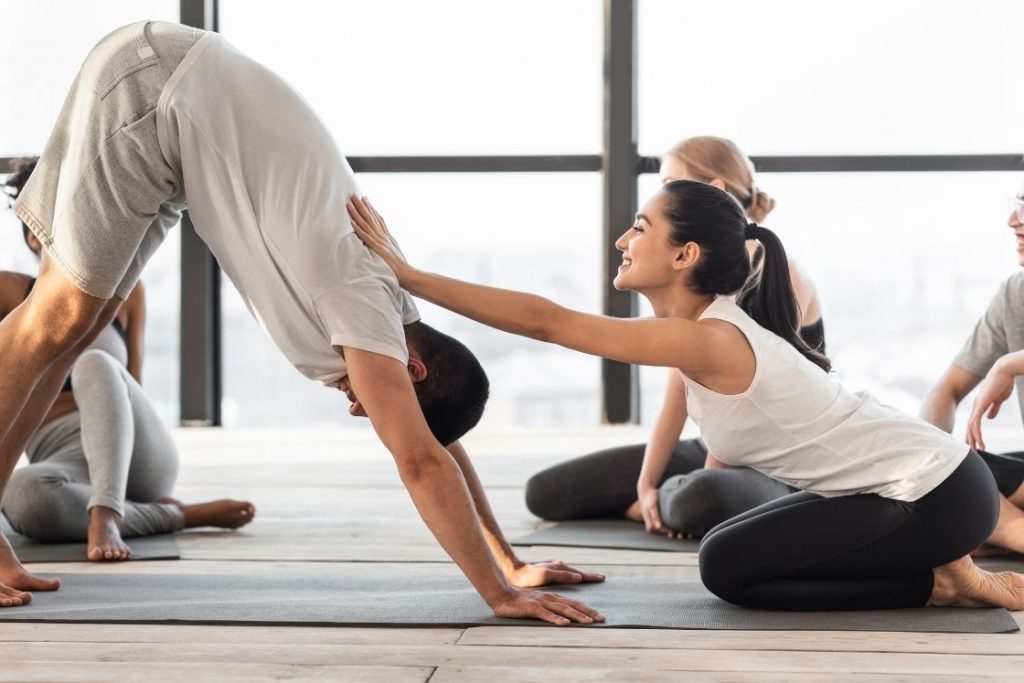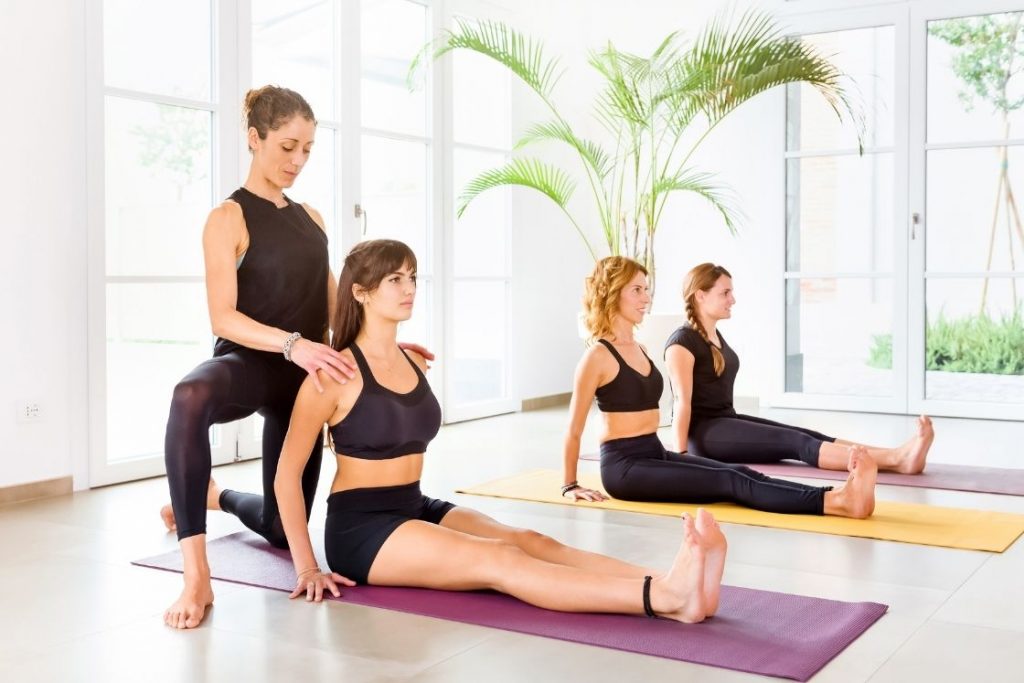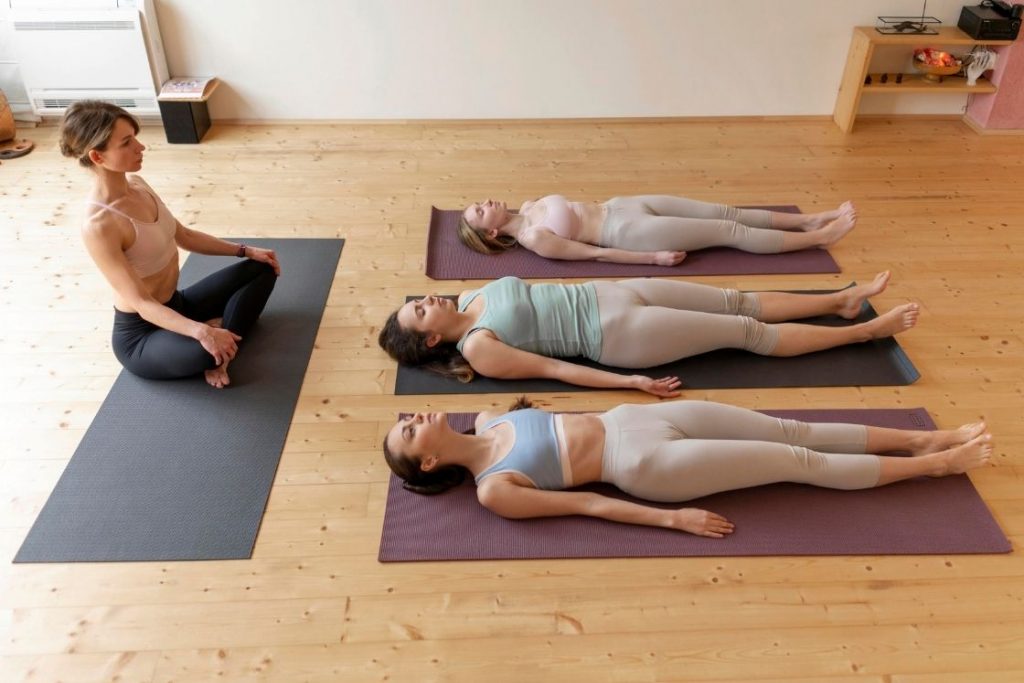
The first time of anything is exciting, sometimes also a little nervy. Why? Because we paint quite a picture in our minds of the first-time situations we are going to witness. Similar feelings visit on our first day of the job or our first big presentation, don’t they?
So, now that you have finally enrolled in the yoga class and painted a scenario of your first ever yoga session, let’s take a genuine tour of it. Let’s try to examine how your first yoga session will look and if there are certain things you can prepare for it in advance.
What to expect in your first yoga class?
Before joining a yoga class, there are a lot of things you must have considered. Now when you have decided, you must be figuring what it will be like in a yoga class.
If you’re brand new to yoga, your first yoga class will definitely be full of mixed feelings of excitement and nervousness. You might be worrying about a lot of things: How it’s like to be come into Downward Dog Pose? Will I be able to follow the teacher’s instructions? What others will think of me if I am not able to do even the easiest pose.
In going to a regular yoga class, you can expect these things in your first yoga session;
- The class probably will be full of beginner as well as experienced yogis
- There will be silence and peace within the practice room
- You will have to set up essential props and yoga mat before class begins
- The teacher might ask you about your past expereince and physical condition
- The class probably will begin with a prayer and OM chant
- Apart from physical exercises, there will be breathing and meditation exercises
- You are expected to practice mindfully
- Your teacher may offer physical adjustment during class
- You may not be able to do all poses in first try
- You may have emotional experience after the class
- The class will end with Savasana
- Expect to feel body pain next day
1. The class will be full of beginner as well as experienced yogis
If it’s not a beginner specific class, a regular yoga class is probably always full of multi-level students; from beginner to intermediate and experienced yogis, all practising yoga under the same roof. The instructor has this understanding, but you while practising may have to remind yourself of this often.
Some practitioners may be able to do a yoga pose quickly without any problem, whereas others may need a slower pace to attain the final posture. You as a first-day student should not expect to do every pose quickly that you are ahead of many. Depending upon the flexibility of each person in the class, their progress will vary.
You might be worried about your limitations of doing different bending, twisting, and balancing yoga poses. But in a studio yoga class, the teacher can give you more attention than others to make you adjust wherever possible. Moreover, you can always find your level practitioners in class and practice next to them.
Indeed, you don’t have to match your pace with other practitioners in class at all; remember you’re in a yoga class not in a sport or exam for competition. The real benefit of yoga is in the mindful practice itself not mastering a pose.
2. There will be silence and peace within the practice room

Silence and peace are some of those key things because of which yoga is practised today by many people. And this you will observe at the moment you enter yoga studio premises.
As soon as you enter the yoga practice room in the studio, you will see all the practitioners are silently setting up their space or others might doing warm-up exercises. You are expected to be silent and refrain from chatting with others. Of course, you can ask others to help you set up your space but that too in a silent manner.
Maintaining this silence is a yoga class etiquette one must follow.
Moreover, in yoga class etiquette, you are expected to take off your shoes outside the practice room. Also, keep any of your gadgets outside the practice room in flight mode. Try and skip the perfume or strong scents until after class.
3. You will have to set up essential props and yoga mat before class begins
Generally in a yoga class, you are expected to set up your practice space by own before class begins. Setting up your space means choosing a place to put up your mat and gathering all essential props like blankets, blocks, straps, etc. next to you that you will be needed during class.
Before the teacher comes and class begins, you can use the time to set up your space, do some stretches, or simply sit in silent meditation to ground your body and mind.
4. The teacher might ask about your past expereince and physical condition
In your first yoga class, before the teacher enters the practice room, s/he probably will want to know about your previous yoga experience and if you have any physical condition.
At this step, you have to be clear with your teacher about any injuries and conditions you are going through or have been in past. Also, let your teacher know what’s your purpose of joining the yoga class and what things you know about yoga, theoretically and practically as well.
Your basic information of experience and physical condition will help the teacher know what level of attention you need in class and which practices you should avoid (If some contraindications are there).
5. The class probably will begin with a prayer and OM chant
A typical yoga class usually start with an opening prayer followed by OM chant. There are different opening prayers in different yoga styles. However, Patanjali Prayer is one of the common chants that generally happens at the beginning of class.
The class opening prayer is purely in Sanskrit verses. First teacher will recite these verses and then you have to follow the chant with other students. You can remain silent or chant internally if you’re not comfortable reciting the words. After prayer ends, OM is chanted 3 times with long and deep breaths.
There is also a possibility that you feel lost and uncomfortable. Give it time and you will grow comfortable with the yogic atmosphere around you. With time and practice, you will understand the process better as you proceed in your practice.
Indeed, you may come across many Sanskrit words during the yoga class that sounds totally strange to you. For example, Namaste is the most common word used to greet fellow yoga practitioners. You can know these yoga Sankrit words in advance to understand their meaning and use.
6. Apart from physical exercises, there will be breathing and meditation exercises as well
The first session of yoga can leave you wondering as it involves breathing and meditation techniques as equally as the physical exercises. Yoga is a holistic science that comprises not just the asanas (physical postures), but much more than that.
You can be asked to sit in the meditative postures and focus on your breathing. The first yoga session will offer more relaxation than hectic physical postures. More emphasis will be given to stepwise teaching and thus it can be slower than you actually thought.
The instructor will not ask you to perform a yoga posture immediately upon arriving. But the class can start with a prayer and a few minutes of meditation following it. Similarly, the session may end with a relaxation and prayer following it.
7. You are expected to practice mindfully

In the first yoga session, the instructor might ask you to focus on stepwise learning, rather than completing the posture faster. Even the steps of the postures are taught and asked to practice at a slow pace.
Mindfulness is the central theme of any yoga style. Thus, no matter which style of yoga class you are in, the key is to be mindful while doing every movement in yoga. Your first yoga session can hence involve a lot of pauses when you are learning the steps of the postures.
Even after the completion of the posture, the instructor can tell you to remain stable and concentrate on your breathing. After the practice too, no rush to release the posture is appreciated. Yoga recommends slow and mindful movements and you will learn this as you begin your first session.
8. You may not be able to do all Poses in the first try
When you attend your first yoga class, you may have imagined yourself doing the best postures or getting praised by the teacher. However, when you actually perform it, there can be difficulties you did not imagine.
It is important to remind yourself during your first yoga session that there are going to be difficulties. Some poses are not well understood by us and some we are unable to perform because of a lack of flexibility.
If you are not used to exercising, your body may not have the flexibility that is needed. For this, there can be some poses that you will be unable to practice to their perfect state. But yoga is a process and with regular practice, you can gain the flexibility to attain the posture as it is.
9. Your teacher may offer adjustment during class
Your teacher might ask whether you’re happy to be adjusted during the class. It’s lovely to receive hands-on adjustments as it can help you to gain better alignment or move you into a deeper expression of a pose.
When you are new to yoga, the teacher generally provides you hands-on adjustments in class for better alignment or deeper posture. You can tell your teacher if you prefer not to be touched. You don’t have to have a reason to specify this.
When the instructor is teaching a new pose, he or she will ask you to listen attentively. The teacher also tells about the contraindications and precautions of new posture when demonstrating. Listen to that carefully and perform accordingly with the help of your instructor.
10. The class will end with Savasana

Laying down in Savasana is the relaxation part of the class. The teacher may ask you to comfort yourself in Savasana using a blanket and bolster.
Savasana is where we fully absorb the benefits of postures. It calms the central nervous system and brings the breath back to normal. It’s the part of the practice where we can truly allow ourselves to simply Be.
11. You may have emotional experience after the class
After your yoga session ends, you can have different emotions; you might feel crying, sad, angry or mixed emotions. These all are the after-effects of yoga and it’s normal to have such emotions.
During yoga, our body and mind learn to be centred in the present moment. In this process, the body begins to relax and thus physical tension dissipates and we start feeling the emotions that keep going on within us.
The emotions are not the result of yoga. What yoga does is just make us realize what’s going on within us.
12. Expect to feel body pain next day
After the first yoga class, where you have twisted and stretched your muscles that previously had not much activity, there is a chance that you may feel sore. It is a common result when you do yoga for the first time.
Do not panic if you feel a little heavy or sore the next day. It is absolutely normal and safe. The soreness will eventually reduce as an outcome of practice.
The factors discussed above must have cleared your thoughts of how your first yoga session can be. Even if it is or is not as you imagined, your first yoga class is going to be a memorable learning experience.
Preparation for Your First Yoga Class
Just as you prepare for a big presentation with proper apparatus, rounds and rounds of rehearsals, and other essentials, your yoga class also needs preparation.
Now let’s get you ready for the yoga session with the following preparatory tips.
Prepare physically and mentally
The yoga practice follows many regulations other than only performing it on the mat. Thus, before attending your first yoga session, mentally prepare yourself for the changes it is going to bring.
If you have signed up for an early morning class, you will have to inculcate the habit of getting up early. Moreover, the first few sessions of yoga can cause soreness or pain in some body parts. Prepare yourself for such events and remember they are only going to bring the best out of you.
Be equipped appropriately
Before going to your first yoga class, be appropriately prepared in terms of the apparatus that you need. First of all, you should have a fine yoga mat that can support you through intense level practices.
Wear clothes that are comfortable and aid your yoga practice. Prefer snug and sweat-wicking fabric that comforts you during rigorous sequences. Wear clean and fresh clothes to your yoga class. They will keep you mentally encouraged throughout the session.
Other things you need to carry are a water bottle and a towel. These are your helpers when the yoga session goes all-sweaty and rigorous. Keep your water bottle and towel near you when you practice.
The studios provide props for the sequences that need them. However, if you are taking private classes or practicing alone, possessing a few props like blocks, yoga straps is useful.
Some Ashtanga Yoga or Hatha Yoga classes teach a few Kriyas (cleansing techniques) as well. For them, you will need neti pots or catheters, which you can buy when your instructor asks you.
Follow class manners
When you are attending the yoga session for the first time, observe the manners of the class. Arrive at the studio or place of class a little early. Get familiar with the place and its setting. Introduce yourself to the instructor and communicate with them your concerns or doubts, if any.
Get familiar with the new words or concepts that are used in the yoga class. You will learn them eventually with practice. Observe the manners of everybody and try to get in sync with them.
If you don’t understand any sequence or pose, ask your teacher right away. Try to be participative in your first yoga session. This will help you bond with the teacher.
Remind yourself to practice mindfully
Yoga is about a mindful practice of physical and breathing exercises. Even if it is your first day and you are excited about learning so much, remember to maintain mindfulness in your practice. Slow and attentive practice will gain more benefits out of the yoga class.
In your first yoga session, the instructor may ask you to focus on your breath during meditation. It can be a challenging practice as you are new. The mind may wander from thought to thought, distracting you. Nonetheless, try to focus on the present and listen to the instructions of the teacher.
Avoid heavy eating before the class
It is recommended to practice yoga with an empty stomach. It is because food already in the digestive system can reverse the effects of yoga and make you feel nauseous. That’s why make sure you are not eating anything solid before your yoga class.
However, water or a little liquid diet is considered fine. But most yoga experts recommend keeping your stomach fully empty before your yoga class. Also, it is suggested to not eat anything immediately after the yoga session. You can eat solid food two hours and liquid half an hour after the yoga session ends.
Remember that relaxation is as important as stimulation
Yoga practice is a combination of stimulating your body and mind as well as relaxing them. Your first day at a yoga class can be overwhelming as you loosen your body to exercise for the first time. Hence, it is important to practice the relaxation techniques mindfully.
Your yoga classes will not only be the fat-burning yoga postures and sequences. It will also include the relaxation part substantially. Practice it carefully as instructed for benefitting better from their effects.
Final Thoughts
You can get the best out of your first yoga class if you are prepared well for it. The first experience is going to determine your dedication towards the teacher and yogic process as a whole. So, don’t forget to refer to the tips and make your experience of the first yoga session memorable and fulfilling.




